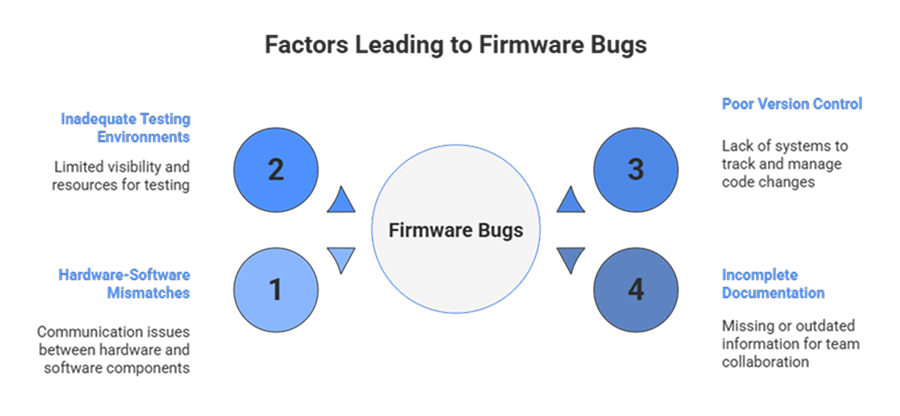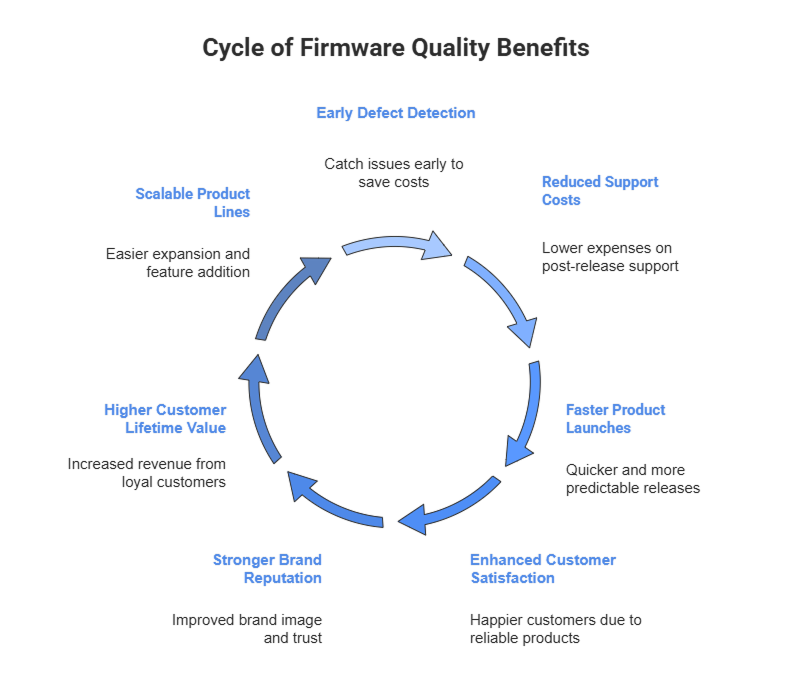
When a new electronic device hits the market, most of the attention is on its sleek design, powerful features, and innovative software. But what truly makes it work is the firmware.
This essential software acts as the bridge between a device’s physical components and its higher-level applications, dictating everything from its responsiveness to its energy efficiency. The quality of this unseen code is paramount, yet its flaws are often overlooked until they surface as catastrophic failures.
A common assumption is that a firmware bug is a minor, fixable glitch. In reality, a tiny firmware defect can have a disproportionately large and devastating impact, costing thousands in product recalls, delayed launches, and lost customer trust. The financial and reputational fallout from a single, poorly managed bug can threaten the very existence of a product line, or even a company.
In this post, we explore the often-overlooked costs of firmware defects and provide actionable strategies to prevent them.
The Real Impact of Firmware Bugs: Quantifying the Consequences
The impact of a firmware bug extends far beyond a simple device malfunction. It sets off a domino effect that can erode a company’s financial stability, damage its brand, and disrupt its core operations. A holistic view reveals that these consequences are systemic, compounding over time to create a significant burden on the entire organization.
Financial Costs: The Domino Effect on the Bottom Line
The direct financial toll of poor software quality is staggering. According to a report by the Consortium for Information & Software Quality (CISQ), the economic impact of poor software quality in the US reached a remarkable $2.41 trillion in December 2022, a figure that increased by $330 billion in just two years. For every dollar spent on resolving a bug post-launch, companies may incur an additional $30 in secondary costs, such as legal fees and customer compensation.
The most critical financial risk lies in a concept known as the “cost multiplier” or the “1-10-100 rule.” This principle illustrates that the cost of fixing a bug escalates dramatically as it moves through the development lifecycle. Fixing a bug during the design phase may cost a nominal amount, while the same bug found during development can cost ten times more. Once that same bug reaches production, the cost to remediate it can multiply by one hundred times or more. This exponential increase is due to the fact that late-stage defects often require extensive rework, resource reallocation, and complex patch management, all of which drain budgets that could otherwise be used for new feature development.
| Bug Detection Phase | Relative Cost to Fix |
| Requirements & Design | $1 |
| Development & Testing | $10 |
| Post-Production & Release | $100+ |
Time & Reputation: The Erosion of Market Advantage
Beyond monetary losses, firmware bugs can exact a heavy price in terms of time and market standing. A significant finding indicates that over 50% of development teams experience project delays due to incomplete or vague requirements, and poorly defined architectural strategies can contribute to 70% of firmware issues. These delays directly impact time-to-market, allowing competitors to gain an advantage and seizing a larger share of the market. When projects are consistently delayed due to late-stage bug fixes, a company’s reputation for timely delivery and reliability is severely compromised.
The erosion of a brand’s reputation is an insidious and often irreversible consequence. A single poor user experience can lead to customer churn, with some reports showing that 32% of users will abandon a brand after just one bad encounter. In the world of connected devices, where a flawless experience is expected, a buggy product is often interpreted by users as a sign of company apathy.
The Ultimate Cost: Public Safety and Human Health
For devices in transportation, medical, and industrial sectors, firmware errors move from inconvenience to existential risk. The ultimate cost is not measured in dollars, but in public safety and human health.
A prominent, though generalized, example is the class of bugs found in automotive systems. In one well-documented case involving a major manufacturer, a firmware error in the electronic throttle control system could misinterpret the driver’s input, leading to unintended acceleration. This type of flaw, which involves misreading a critical sensor input like the accelerator pedal position, directly resulted in accidents and fatalitie.
Similarly, in highly regulated industries like healthcare, a software/firmware failure can be a matter of life and death. For instance, a Class I Recall was issued for the Philips Mobile Cardiac Outpatient Telemetry (MCOT) Monitoring Service Application due to a software configuration issue that prevented high-risk ECG events from being properly routed to clinicians. This failure to transmit critical data resulted in missed alerts and was associated with patient injuries and two reported deaths, demonstrating that firmware failures are not just inconveniences but require strict regulatory compliance and absolute reliability.
Operational Costs: The Burden on Internal Teams
The burden of firmware bugs extends to the operational fabric of an organization. When defects reach production, they create a reactive cycle of patch management that consumes significant resources. Patching a production system is a complex, multi-stage process that requires meticulous scheduling, communication, rollback plans, and cross-team coordination to ensure operational stability. This reactive work diverts engineering and IT teams from new development and innovation, creating a drain on efficiency that is difficult to recover from.
Late-stage defects also overwhelm customer support channels, as bug-related tickets can increase support costs by an average of 40%. This overflow of support queries strains resources, prolongs resolution times, and further exacerbates customer dissatisfaction. The true cost is not just in the hours spent debugging, but in the lost opportunity to focus on strategic work, improve existing systems, and drive long-term value for the business.
Common Sources of Firmware Bugs: A Technical Deep Dive
Understanding the consequences of firmware bugs is only half the battle; preventing them requires an in-depth understanding of their root causes. Many of these issues are uniquely tied to the complexities of embedded systems.

The Root Cause: Hardware-Software Integration Mismatches
Modern electronic devices are a complex symphony of hardware and software components. The seamless interaction of physical components like sensors, processors, and controllers with firmware, drivers, and software applications is known as hardware-software integration. A mismatch in communication protocols, interfaces, or timing between these layers can lead to unpredictable behavior and difficult-to-reproduce bugs.
This is a particular challenge in domains like autonomous vehicles and smart devices, where there is no room for imperfection. Successfully navigating this complexity requires cross-functional expertise, with firmware engineers, software developers, and systems architects working closely from the project’s inception. This collaborative, end-to-end approach is essential to address issues that arise at the intersection of hardware and software, rather than in isolation.
The Process Gap: Inadequate Testing Environments
Embedded systems present unique testing challenges due to their resource constraints and real-time demands. They often operate on microcontrollers with limited memory and processing power, making it difficult to get a clear view of system internals during real-time operation. This limited visibility means that bugs are often not caught until they manifest in a live environment, where they are exponentially more expensive to fix.
An inadequate testing environment can leave critical weaknesses in the firmware undetected until they result in a catastrophic system failure or performance degradation. This is particularly true in industries like aerospace and healthcare, where a timing deadline missed by even a millisecond can lead to a disastrous outcome.
The Process Breakdown: Poor Version Control and Documentation
While often viewed as administrative overhead, the lack of proper version control and documentation is a leading source of long-term problems. Failing to utilize a version control system like Git can lead to a chaotic codebase, making it nearly impossible to track changes, collaborate efficiently, or revert to a previous, stable version.
Similarly, incomplete or outdated documentation leads to a breakdown in communication among teams, causing confusion and errors. These process failures create a snowball effect of technical debt, where a codebase becomes increasingly difficult and expensive to maintain.
A well-documented and version-controlled project, conversely, simplifies everything from new feature implementation to critical bug fixes, ensuring that the project’s institutional knowledge is preserved and accessible.
Low-Level Pitfalls That Undermine Firmware Stability
Some of the most insidious firmware bugs are those that arise from the unique low-level interactions and constraints of embedded systems. These are often difficult to reproduce and may not manifest until long after the initial error has occurred.
- Stack Overflow: A stack overflow occurs when a program attempts to write data to a stack that has run out of space, overwriting other critical data or instructions. This is a particularly common problem in resource-constrained embedded systems, which often have limited RAM and lack virtual memory.
- Race Conditions: This occurs when the outcome of a function depends on the unpredictable, interleaved timing of multiple execution threads. A classic example is a global variable being incremented by one thread while being reset by another. If the increment operation is not atomic, a “collision” can corrupt the variable’s value, leading to unpredictable system behavior later on.
- Memory Leaks: Even a small memory leak – where a program fails to deallocate memory after it’s no longer needed – can eventually cause a long-running system to fail due to heap fragmentation. Over time, the heap becomes a “mess of smaller fragments,” making it impossible to fulfill new allocation requests, even if there is enough total free space.
| Common Firmware Bug Types | Root Cause | Potential Consequence |
| Race Condition | Unsynchronized access to shared data from multiple threads. | Unpredictable behavior, data corruption, and system crashes that are hard to reproduce. |
| Missing volatile Keyword | Compiler optimization removes reads/writes to variables modified outside the normal program flow. | Program failure in release builds, incorrect system state, and subtle runtime errors. |
| Stack Overflow | Exceeding the limited stack memory available on a resource-constrained device. | Unpredictable system crashes, data corruption, and security vulnerabilities. |
| Memory Leaks & Heap Fragmentation | Failure to deallocate dynamically allocated memory, resulting in unusable memory fragments. | Gradual performance degradation and eventual system failure in long-running applications. |
Strategies to Avoid Firmware Bugs: The Proactive Approach
The most effective way to combat the hidden costs of firmware bugs is to shift from a reactive mindset of “fixing bugs” to a proactive strategy of “preventing bugs.” This requires a comprehensive, end-to-end approach that embeds quality into every stage of the development lifecycle.
The Cornerstone: Rigorous QA & Testing Practices
A robust quality assurance (QA) strategy is the single most important investment a company can make. It helps to reduce defects, accelerate delivery, and build confidence across teams.
- Unit & Regression Tests: Unit tests validate individual components of the code, while regression tests ensure that new changes do not break existing functionality. By automating these tests, teams can quickly verify the integrity of the codebase with every change, catching issues before they can escalate.
- Integration Testing: While unit tests check individual blocks, integration tests verify that all different firmware modules—such as the MCU drivers, communication stacks (Bluetooth, Wi-Fi), and application logic—work correctly when assembled. This is crucial for catching interface bugs and ensuring seamless data flow between system components.
- Load and Stress Testing: For any connected or high-performance device, Load and Stress tests are essential. They determine the system’s stability and performance limits by simulating conditions far exceeding normal operation. This could involve simultaneously connecting the maximum number of clients, handling continuous high-rate data streams, or running the device at maximum power draw for extended periods. This reveals critical bugs related to memory leaks, resource exhaustion, and race conditions that only appear under pressure.
- Hardware-in-the-Loop (HIL) Testing: HIL testing is a critical technique for embedded systems. It involves connecting the physical hardware to a simulated environment, allowing engineers to test how the firmware interacts with real-world conditions without the need for expensive prototypes. HIL testing allows for continuous, around-the-clock validation and the simulation of diverse scenarios that would be impossible to replicate manually. This proactive approach leads to cost savings, faster development schedules, and enhanced product reliability.
| Testing Type | Purpose | Key Benefits |
| Unit Testing | Verifies the functionality of individual code components. | Catches bugs early, reduces debugging time, and provides a clear picture of code health. |
| Regression Testing | Ensures that new code changes do not break existing functionality. | Prevents “defect leakage” into production and reduces reactive rework. |
| Integration Testing | Verifies that different firmware modules and interfaces work together correctly. | Ensures seamless data flow between components and catches interface bugs. |
| Load/Stress Testing | Determines stability and performance limits under extreme or sustained usage conditions. | Uncovers memory leaks, resource exhaustion, and race conditions under pressure. |
| Hardware-in-the-Loop (HIL) Testing | Validates how firmware interacts with real-world hardware in a simulated environment. | Enables continuous testing, reduces reliance on expensive prototypes, and accelerates time-to-market. |
The Automation Advantage: Implementing CI/CD Pipelines for Firmware
The principles of Continuous Integration/Continuous Deployment (CI/CD) have been transformative in software development, and they are equally critical for firmware. A CI/CD pipeline automates the stages of building, testing, and deploying firmware updates, ensuring that every code change is thoroughly vetted before it can be integrated into the main codebase.
This automation minimizes human error and enforces a consistent, repeatable process. By integrating automated security checks and testing into the pipeline, teams can “shift left” – catching vulnerabilities and defects as soon as they are introduced, before they become expensive problems. This approach directly reverses the cost multiplier and ensures that quality is built into the process from the beginning.
The Collaborative Imperative: Early Integration
The “shift left” philosophy is not just about technology; it’s about a fundamental change in process and culture. It requires close collaboration between QA engineers, developers, and hardware designers from the very start of a project, even before coding begins.
This early collaboration is crucial for defining clear requirements, anticipating hardware-software integration challenges, and designing a testable architecture. By involving QA early, teams can proactively identify potential risks and prevent negative consequences, rather than reacting to them after the fact.
The Code Quality Imperative: Code Reviews and Documentation Standards
Peer review is a powerful tool for improving code quality and fostering a shared sense of ownership. A well-defined code review process, which includes keeping changes small, assigning specific scopes to reviewers, and discussing design issues beforehand, can catch subtle bugs and logic flaws that automated tools might miss.
Similarly, comprehensive documentation is not a chore but a strategic asset. Well-documented firmware, which includes clear inline comments and architectural overviews, ensures maintainability, simplifies updates, and is essential for meeting compliance requirements in regulated industries.
The Right Tools: Reliable Development Frameworks and MCUs
The choice of microcontroller unit (MCU) and development framework is a foundational decision that impacts every aspect of the project. Selecting a robust, scalable MCU from a reputable manufacturer, such as NXP, ensures a stable hardware foundation that can support the device’s evolving feature set and performance demands. Partnering with a team that has a proven track record of working with these platforms can further reduce risk and accelerate development.
Long-Term Benefits of Proactive Firmware Management
Viewing firmware quality as an investment rather than a cost yields significant long-term business benefits. By catching defects early, companies drastically reduce post-release support costs and rework, freeing up development budgets for high-impact innovation. This proactive approach also leads to faster, more predictable product launches, improving time-to-market and giving a company a critical competitive edge.
Ultimately, robust firmware management builds a foundation for long-term growth. Products with reliable firmware lead to enhanced customer satisfaction and a stronger brand reputation, which directly translates to a higher Customer Lifetime Value (LTV) and sustainable revenue growth. A well-documented, modular firmware architecture also makes it easier to scale product lines, add new features, and stay compatible with emerging technologies, future-proofing a company’s entire product ecosystem.

How Developex Can Help: Your Partner in Prevention
Developex provides a holistic, end-to-end solution that addresses the full spectrum of firmware development challenges. The firm’s services are designed to help electronics companies build high-quality, reliable, and scalable products from the ground up, preventing the hidden costs of firmware bugs before they can materialize.
At Developex, we offer a full range of firmware development services, including custom firmware creation, hardware inspection, and post-development support. Our team of 350+ IT specialists possesses deep expertise in MCU integration, device driver development, and RTOS integration, ensuring that the critical bridge between hardware and software is built on a solid foundation. This end-to-end support is essential for projects where complex hardware and software interactions are a primary concern.
Our expertise is supported by a robust portfolio of successful projects across a variety of industries, including consumer electronics, audio and video devices, gaming peripherals, smart home and IoT devices, and automotive systems.
Final Thoughts,
The hidden costs of firmware bugs – from financial losses and operational inefficiencies to irreparable brand damage – are far too significant to ignore. The most effective defense is a proactive, disciplined approach to firmware development that prioritizes quality from the very beginning.
By adopting rigorous QA practices, implementing CI/CD pipelines, enforcing code and documentation standards, and leveraging expert support, companies can build products that are not just functional but fundamentally reliable.
Quality firmware is not a luxury; it is a necessity for long-term business success. It is the silent guarantee that a device will perform as expected, building customer trust and securing a competitive advantage in a crowded market.
Want to ensure your firmware is bug-free and your product launches are successful? The Developex team is dedicated to helping electronics companies deliver reliable, scalable products on time and with confidence.






